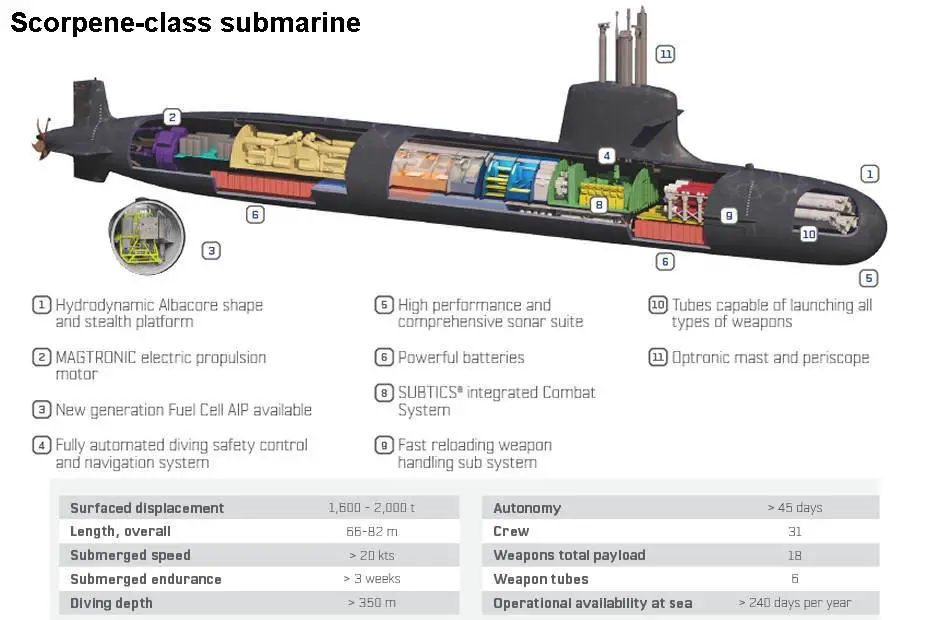DRDO’s propulsion system in focus
Context:
The Naval Group, the French co-developer of these submarines, has already spent over 100 crores in three workshops with tools and infrastructure for important tasks and spares for maintenance of these submarines’ critical systems as India starts talks with France about three additional Scorpenes.
What are Scorpenes Submarines?
- Development: The French Naval Group (formerly DCNS) and the Spanish business Navantia collaborated to develop the Scorpène-class submarines. An adaptable and cutting-edge diesel-electric attack submarine was the goal of the project.
- Design: The Scorpène-class submarines have streamlined hulls that are reduced in acoustic signature and geared for stealth. The submarines are roughly 60 meters long (197 feet), with a displacement of 1,500 tons.
- Propulsion: The propulsion system for these submarines is a diesel-electric one. Diesel engines are typically used by them for surface activities and battery charging. They do, however, also have an air-independent propulsion (AIP) system, which enables prolonged submersion without the requirement for periodic surface.
- Air-Independent Propulsion: The Scorpène-class submarines’ air-independent propulsion (AIP) system enables them to stay submerged for longer periods without access to atmospheric oxygen. Eliminating the need to surface and risk being discovered, dramatically improves their ability to remain undetected.
- Combat Systems: Sonars, periscopes, and numerous surveillance and targeting systems are just a few of the sophisticated combat equipment and sensors available on Scorpène-class submarines. These devices help submarines be more aware of their surroundings and better detect and engage threats.
- Weapon System: Torpedoes, anti-ship missiles, and maybe additional armaments are mounted on the submarines depending on their configuration and customer demands. The submarines’ armament systems provide them with a potent offensive capacity against surface vessels and other submarines.
- Versatility: The Scorpène-class submarines are built to carry out a variety of tasks, including anti-surface, anti-submarine, intelligence, and surveillance operations. They are excellent for a variety of operational circumstances due to their versatility.
- International Adoption: Several nations have decided to equip their navies with Scorpène-class submarines. For instance, Scorpène submarines have either previously been commissioned or ordered by Chile, India, Malaysia, and Brazil. This indicates how highly regarded the class’s competence and dependability are throughout the world.
What is Air-independent Propulsion and how is it beneficial?
- System Description: The French shipyard Naval Group created the air-independent propulsion (AIP) system known as the MESMA system, which is non-nuclear. The Scorpène-class submarines are intended to utilise it.
- Nuclear Propulsion Modified: The MESMA system is based on a nuclear propulsion system modified by the Naval Group. The MESMA system produces heat by burning stored oxygen and ethanol instead of using a nuclear reactor.
- Operating Time: Depending on the speed, a Scorpène-class submarine can stay submerged for more than 21 days with the MESMA system fitted. Submarines with these extended endurance capabilities can complete lengthier missions without having to surface or snorkel for extended periods.
- Hydrogen Fuel Cell AIP Modules: Second-generation hydrogen fuel cell AIP modules are also being developed by Naval Group for the next Scorpène variants. As an alternative to conventional diesel-electric propulsion systems, hydrogen fuel cell technology offers longer submerged endurance and a smaller acoustic signature.
How is India planning to implement this propulsion system into Indian Naval ships?
- Negotiations: The purchase of three more Scorpenes submarines is the subject of ongoing negotiations between India and France. The Naval Group and Mazagon Dock Ltd. (MDL), Mumbai, inked a memorandum of understanding (MoU) for cooperation on these submarines on July 6.
- AIP System (Air Independent Propulsion): The Indian Defense Research and Development Organization (DRDO)’s AIP technology would be installed aboard the three extra Scorpene submarines. The AIP system is intended to increase the endurance of the submarines. The DRDO-developed AIP system is being qualified for installation aboard the Scorpenes by the Naval Group.
- AIP Modules to be Installed: The Indian Navy intends to install AIP modules during the refit procedure on all Scorpene submarines. By the end of 2024, it is anticipated that the INS Kalvari will be the first submarine to receive this overhaul. The Naval Group and DRDO are helping to integrate the native AIP module onto the Scorpene submarines.





